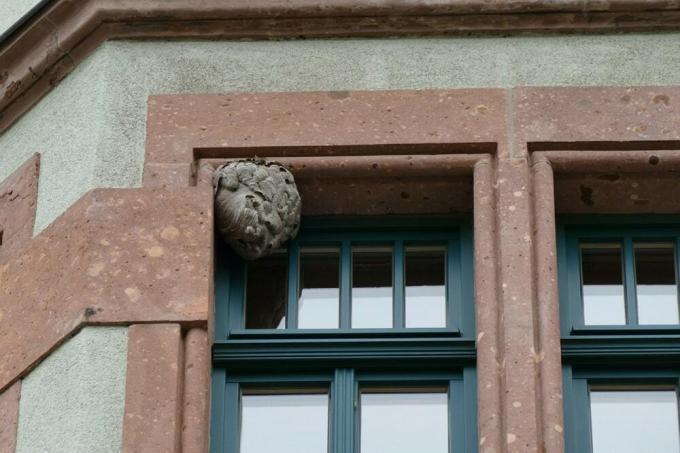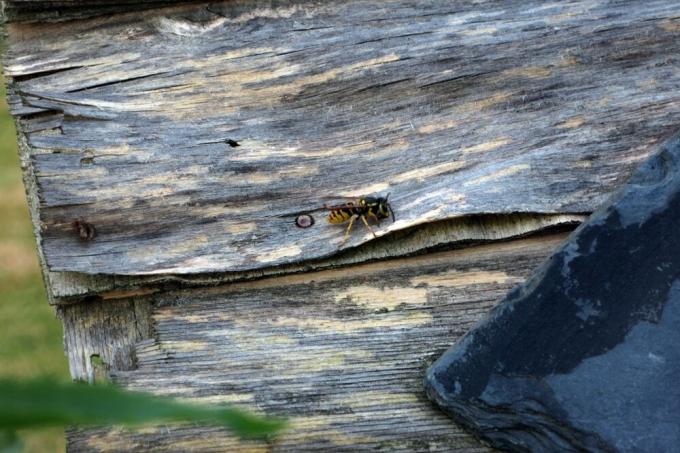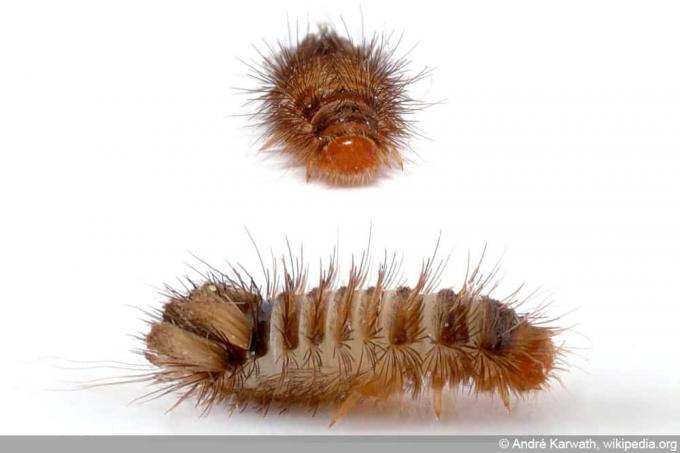

Table of contents
- Little wasps' nest customer
- Remove wasp nest
- Old nest, new nest?
- Prevent new nest building
- Conclusion
“Get rid of” by itself is a bit imprecise, because you can certainly get rid of a pile of pulp on the wall without advice. If you would like to know when wasp nests could still be inhabited, whether a wasp nest must be removed or old wasp nests encourage new queens to build nests, you will be informed in detail below:
Little wasps' nest customer
Before you set out to remove a wasp nest somewhere in a hidden corner of your home, it would be useful to know if that nest is empty. A visual check from a distance shows that most of the wasps are no longer buzzing around the nest. But you probably want to be sure that you don't encounter a single wasp, either stragglers or a wintering queen, during the removal and cleanup operation.
The odds of this happening depend on how big the nest is and when you noticed any recent activity around the nest. Small nests, around which nothing has been buzzing around for a while in October, are almost certainly empty by the beginning of November and can be eliminated. These nests are left by short-lived colonies of wasps that died by early fall. With these small nests, it is also quite possible that you will notice the nest for the first time in winter - the small colonies of often dark-colored wild wasps are not aggressive and go (fly off) people as much as possible the way.
The eye-catching, larger nests that seem worth considering what's inside this artful nested structure are burrows of our most “annoying” wasp species, the “common wasp” and the “German Wasp". You will certainly not only notice these nests in winter, because there was a lot going on there from May: In May, the queen starts building the nest started, over the summer wasps could be observed coming and going, and in late summer there was a lot of swarming all around the nest. With good reason, from September/October the wasps of these species slowly die and shortly before they become more and more aggressive.
By November at the latest it should be quiet around a wasp nest of some size; If you haven't seen any flying wasps for several days and the first night frosts are over, you can be sure that the wasp nest is now empty. The wasp colony has now died, the only survivor is the queen, who overwinters to build a new nest next year. Means for you: clean air, because the queen does not hibernate in the old nest, and she does not use the old nest again, but always builds a new nest.
Here are some nice pictures of the art of nest building of our most common species: www.aktion-waspenschutz.de/Wespenarten/Deutsche%20waspe/germanicaUnten.htm, www.aktion-waspenschutz.de/Wespenarten/Gemeine%20waspe/vulgarisIndex.htm.

Just for the sake of completeness: before winter, when the nest is still full of life, you must not simply remove it. Wasps are useful to our society because they pollinate plants and plants are the basis of our diet; for your garden, because they keep populations of harmful insects at manageable levels, for you, because they take care of flowers in the garden and are responsible for ensuring that the house and garden are not swarming with other unpleasant little animals. Therefore wasps are under nature protection, according to § 39 BNatSchG any willful disturbance of wasps (and other wild animals) is forbidden, wasps are allowed not be caught, injured or killed without reasonable cause, and their habitats shall not be disturbed or destroyed without reasonable cause. When there is a reasonable reason is not up to you personally - but in the event of a conflict you will get help from many sides. If in doubt, your local environmental office will show you the way.
Remove wasp nest
An old wasp nest can therefore be removed in winter when no wasps have been sighted nearby for a long time. This is the quickest way and with the least mess:
- Provide a vacuum cleaner, preferably with a willing helper, of course
- You will also need a large (blue) garbage bag
- A sharp knife or a wide flat spatula, depending on the size of the nest mount
- A wire or bristle/plastic brush under the nest, depending on the material
- Open the bag under the wasp nest
- Cut or stab the wasp nest so it falls into the bag
- Takes the hassle out of thinking about rumors about wasps left in the nest/overwintering queens
- Brush as much of the wasp nest residue on the wall/in the roller shutter box into a bag as possible
- Dispose of the rubbish bag, brush and vacuum away residue that is difficult to reach
That's it, then you can thoroughly damp clean the nesting area so that the familiar smell doesn't encourage the next queen to build a nest. But clever queens will find uniquely good locations time and time again, so you'll be brief should consider whether there is a need to remove the nest from a spot where it is not too crowded disturbs.
Old nest, new nest?
There would be an argument for not removing the wasp nest until next spring: the queen overwinters somewhere in close by, and when she sets about making the new nest next spring, she will look for the best one, just like last time Place. If the spot you picked last time is the only spot far and wide where a wasp can build a nest in peace, it would make sense to leave the nest hanging until spring. Because the biologists are pretty sure that it has never happened that a wasp queen moves into an old nest.
However, this decision requires the assessment of the environment "from the perspective of wasps". Even humans can think of some of the criteria that play a role in choosing the place for the nest: Nice and quiet, one Opportunity to get outside in the garden, people with a gift for empathy enjoy it and think about it a little longer further. If it turns out that the roller shutter box (with the old wasp nest that needs to be removed) is the only place you can be as a wasp queen in this If the space is reasonably able to build a nest, you can leave the nest hanging until spring and make sure there aren't wasps again next year collect.

For animal lovers ecologically interested people, there are other motives for not removing an abandoned wasp nest immediately:
- If you want to ensure "more ecology in the environment", leave the nest hanging for a second use
- Many insects like to use the artfully built wasp nests as winter quarters
- It is usually useful insects such as lacewings that devour house dust mites and houseplant-eating aphids
- If you have already come to appreciate wasps as pest controllers:
- Even if no new queen moves into the old nest, it spreads a "homey smell"
- If in the environment z. B. If the garden shed gives more opportunities to build a nest, other queens may build nests there
- This is particularly likely in the case of small, free-hanging nests of "non-annoying wild wasp species".
- Such peace-loving wasps will not bother you even with multiple settlements, but only eagerly devour insects
- These mini nests z. B. of the house paper wasp show an open construction
- It is even said that the wasps use the nest for several years
Prevent new nest building
If the nest is not in the garden shed but in the house, but nature prefers to stay in the garden, the nest is gone. After the final wet cleaning with hygienic cleaner, which ensures that "foreign wasps" no longer sniff out familiar smells, you can do that Equip the area in question so that it becomes unattractive to wasps: lavender, cloves, frankincense and lemon should not be used by most wasps like; some essential oils that do not smell like native plants, such as eucalyptus, manuka, niauli and patchouli are certainly worth a try.
But you are dealing with living beings doing the most important job of all (conservation) when yours "offered" rooms are great nesting places for wasps, with free access a queen will probably come to you again and again get lost
"Free access" for a wasp is given even with very small crevices, but you can of course try to make your house a little "more wasp-proof":
- Install as many fly screens as possible
- Normal models are enough, expensive special installations rarely bring more
- If you have a lot of people moving from the house to the garden during the summer months, it is worth installing automatic door closers
- If the door to the garden is only constantly open so that the dog or cat can get in and out, a dog or cat enclosure is a good idea. Cat flap maybe an idea
- Openings of roller shutter boxes can be closed to protect against wasps
- Wooden beams should no longer be chosen as a nesting site by wasps if they are varnished
- If you don't want that, you could ask about wasp repellent waxes and oils
- Wasps should not nest under the eaves if the gutters are made of copper

If prevention fails, or the wasps are particularly stubborn in your area, you can then stop the colonization of wasp nests in the spring: from the beginning April the queens of the German wasp are out looking for nests, from mid-April the queens of the common wasp, the queens of other wild wasp species later in the Spring. Worker bees do not appear until May when the nest is complete, so queens fly around lonely and alone. However, they are quite easy to recognize, namely "mighty buzzers", 4 mm longer than normal wasps and thick and round.
Now you surely have better things to do than wasps flying around one by one all day long Keeping an eye out - you don't have to, a little attention in the "threatened" area is enough completely. Because then you will not miss when a wasp queen starts building the nest. The quicker you discover them, the easier it is to destroy the work you've started. The queen wasp will then leave her home in frustration and start building her nest again somewhere more hospitable.
Conclusion
There are surefire ways to get rid of wasp nests indoors, but they can all be used in the garden. Surround your property with a "ring of nature" on the outer edge: hedges with trees in between that invite insects to build their nests, insect hotels built in front of or in between; and if you want peace from wasps forever, all you have to do is get some hornets. The inhabitants of a small hornet's nest, around two dozen animals, are supposed to eat tens of thousands of wasps in one summer. As pure insectivores, hornets are hardly a nuisance for humans, and a nest in the garden is often not noticed all summer long. You can "grow" hornets by building them a suitable insect hotel, or, still better, the no longer used, half-rotten aviary at the back of the garden to the hornet apartment rebuild. This conversion is quick: One or two euro-sized holes in the floor, and the hornets (who need a draft in the housing to regulate the temperature in the hive) are satisfied with the offer. Bumblebees and wild bees also like such dwellings, but housing them in our times of need for insects is also “a good ecological deed”.
 garden editorial
garden editorial I write about everything that interests me in my garden.
Learn more about home pests

Red maggots / larvae in the apartment: what to do?
Red maggots in your own home are the ultimate nightmare sight. A few crippling seconds of shock are allowed. But then decisive and effective action must be taken to make them disappear. But who exactly is "the red enemy" and how is the fight fought?

Compost bin powder against maggots: this is how it works
Especially in the warm season they can hardly be avoided: maggots in organic waste. In addition to insecticides, there is a far better way to keep the annoying guests away: powdered organic waste bins. We tell you how to use it and how it works.

Combat earwigs | 5 remedies against earworms in the apartment
Although earwigs, Dermaptera in Latin, are completely harmless and actually useful animals, the insects are still a cause for panic for many people when they appear in the apartment. Here you can find out how to get rid of the unloved crawlers.

Ants in the brickwork: you can do that now
Ants are useful insects, if they are in masonry they can cause damage to an object. An infestation is not easy to recognize, but if the first signs appear, you should act immediately. Simple home remedies are usually sufficient to drive away the insects.

Identify and fight fleas in the home
Even the thought of fleas in the home is uncomfortable. After all, we associate uncleanliness with annoying insects. They are considered carriers of dangerous diseases. Where are you from? What are the signs of a flea infestation? How do you get rid of them?

Fighting maggots on the ceiling | 7 tips for all rooms
Bedroom, kitchen or pantry, wall or ceiling - anyone who discovers maggots in the house wants to get rid of them quickly. With our help, you can do it quickly and without professional pest control.
